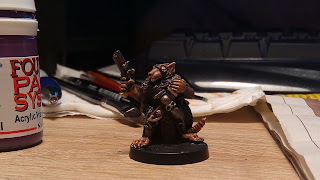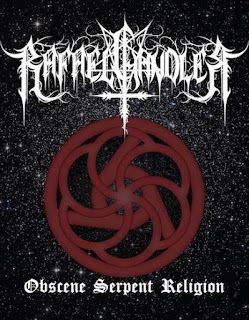 |
Hyperborea, the land of idiotic guardian owls
and buxom blonde sextuplets! |
How should I begin a review about a game that has been twenty years in the making? I could write about how it turned into a vaporware, until it resurfaced five years ago in an Indiegogo campaign, only to be delayed again and again until "Next Friday". I could write about the eccentric neanderthal behind the game, Cleveland Blakemore, his epic threads at RPGCodex, his exeggarated promises, and his ludicrous stories - including tales about his time spent in the development team of the never-released Wizardry 8: Stones of Arnhem, which ironically turned out to be true to some degree. That would deserve an article of its own though, one that I don't intend to write, thus researching the game's absurd history is left to the gentle reader. The dark pits of
RPGCodex are a good place to start.
Grimoire promises to be a David W. Bradely-era Wizardry game on steroids: a classic first-person party-based rpg (or a blobber in short) that's bigger and better than it's predecessor. I have barely finished Wizardry 6 last July when the game appeared on Steam, and it was a huge dilemma whether I should continue playing through the Dark Savant trilogy, or give it a rest and start playing Grimoire instead. I chose the latter in the end, and after eight months and 170 hours of playtime I feel qualified enough to tell you how successful Cleve's attempt at dethroning the king of old-school blobbers was.
Grimoire takes us to the mythical land of Hyperborea, which is guarded by the White Owl (the titular Winged Exemplar). He kept peace through the mysterious cosmic artifact, a clock called the Metronome Mysterium, which is about to unwind soon. Its whereabouts are written on nine tablets, but the imbecile White Owl forgot about their locations, so it's up to a group of adventurers to find them, fix the clock, and prevent the apocalypse. On their journey they will meet the inhabitants of this weirdly messed up kitchen sink world, including vamphyrs related to a lovecraftian creature, drow raiding their own people, holy knights whose order is built on a lie, ratlings controlling their population by mass sacrifice, the local BBEG Lord Ahriman (whom I managed to murder mid-game for being jerk), and many more!
Our motley crew can have up to eight members, who can be both player characters or recruited non-player characters. There are fifteen races, including the usual fantasy clichés with a twist, various manimal races, and some downright weird choices like vamphyrs who are weakened in sunlight, and the aeorbs who are psychic eye-things from another plane. They can be members of fourteen different professions, but not all of them are available during character creation: a few elite professions have such high requirements that it's nigh (or totally) impossible to start as one.
 |
| It was a no-brainer to have an eyeball in my party. |
Character creation is very old-school: you roll the number of bonus points you can spend either on attributes, skills, or hit points. Each race has its minimum scores, further modified by gender, each class has minimum requirements, and each race has a multiplier for your bonus points for each class, making it easier or harder to create certain race-class combos. In my case this lead to three or four hours of jolly re-rolling until I got the party I wanted. Needless to say leveling up includes a lot of randomness too: health, stamina, magic, attribute points, skill points are all awarded randomly, which can lead to a rage inducing cycle of reloading until you end up with a tolerable result, no longer care, or get used to the thought of rotting in hell forever for using a save editor.
If you think planning wasn't hard enough already, then I have some good news: Cleve hasn't released the manual yet. All you have are some short in-game descriptions and hints, but they are neither exact, nor complete. Did you know that drow have shitty spell regeneration? Well I didn't, and neither did the game tell me about it, so I created a drow wizard who felt pretty gimped for a while compared to the other casters in the group. While it has a certain charm to see the community work together in discovering and sharing the details it alienated a lot of people from an already controversial game.
Once your party is done it's time to chose your difficulty, the starting location, and jump into the game. Yes, there are several different starting locations, which can't be reached later if you didn't begin there. Completionists will find this frustrating, but I found it a cool touch, plus it's not a choice in the middle of the game that can alter the rest of your gameplay in unexpected ways.
Wizardry's influence on the game is obvious at first glance: you get a small hand-drawn pseudo-3D game environment framed by a huge ass user interface. There is a lot of information shoved in your face, and you haven't seen the character sheet, inventory, map, journal yet! Heck, I haven't figured out all the symbols on the spell descriptions, or the item inspections... To make things worse Grimoire also borrows the unwieldy shared inventory from Lands of Lore, which is a headache to browse.
 |
That's a nice collection of wands! It would be a shame
if someone stole them... |
If this retroshock hasn't scared you away, then get ready for an awesome experience of raw old-school gameplay. Right after your starting zone you are thrown into the Avian Mountains and given total freedom to explore the area, with zero handholding. You have a vague goal, but its up to you to figure out how to advance through exploring the areas, murderng monsters, communicating with the NPCs, reading obscure hints, and solving puzzles. Once you feel on track and your first major objective is complete the game turns it up to eleven by opening the rest of the world for you. It's freaking huge - and dangerous. While traversing the wilderness you will have to climb mountains and set sail to reach your goals. The dungeons are mostly multi-level and non-linear complexes, with secrets, puzzles, traps, hazards, and of course boss fights. There are only a few settlements in the traditional sense, and even those are far from safe havens. You have to travel a lot, but thankfully the game has an auto-path feature, and later allows you a limited form of teleportation.
Most areas have their own NPCs, some of them wandering, some of them staying in a fixed position. Their dialoge is usually well written, and often humorous, or even absurd. Talking is done by typing in keywords, or using one of the several social options. Their reactions may change based on your deeds, but even if it gets worse (usually for killing someone, saying no to a request, or stealing from them) some money, magic, and diplomacy might help getting them in a better mood. A surprisingly large number of NPCs are recruitable, which can lead to optional quests, dialoges, or even loot. There are even NPCs that start their careers as items - like a corpse waiting to be resurrected, an enchanted sword that has to be invoked, or an egg that has to be hatched.
 |
The situation might look dire, but it's under control!
All they need is some freezing and a few criticals. |
Being aware of your sorroundings and inventory is crucial in Grimoire. You can easily get stuck if you don't recall having an object from earlier, or because you missed a secret door, an illusionary wall, or a clue. Also, always identify your items properly. They might be cursed or have unexpected effects both malevolent and beneficial. Ignoring spells like Identify, Detect Secret, Locate Item, Wizard Eye, or hanging around with low Inspection, Lockpicking, Scout skills can make journey excruciating. Sometimes though they won't help either. Sometimes you need to persistently interact with your environment in different ways (eg. using seemingly insignifican items or sleeping at the right place) to find obscure sidequests.
Time to get to the most exciting part of rpgs: combat! The battles are turn-based and follow the classic Wizardry suit: you select your commands, press BATTLE, and wait until the turn is resolved. Since combatants act in order of their speed their position on the initiative ladder is usually fixed, the only thing messing up this order being magic, which seems to come after item use and attacks. Combat is far from exciting, not only for the minimal visual feedback, but because the game prefers draining your resources slowly: your party usually encounters a small number of enemies, but often (unless you switched off random encounters). While initially even a fire beetle can pose a challenge, later almost every creature becomes trivial. The exceptions though will make you sweat blood. These are the creatures that fight dirty - those with great speed, huge number of attacks, irritating conditions, and instant kills. If half your party is dead or afflicted by a crappy condition after the first turn you are facing one of them. To prevail you need to buff the party with everything you've got, or find a way to cheese them. By the endgame the arms race seems to turn in the player's favour though. With Lethal Blow, Music skills, Freeze, Time Stop spells, and a bit of luck nothing stood in my party's way. I played on Novice difficulty though, so I have no idea how different harder options are.
This doesn't mean that combat is mindless. Trying to use the same cheese without thinking lead to the death of my characters several times, thanks to ignoring some specific details - many of them being common sense. Don't cast fire spells on fire elementals - it heals them. Don't cast frost and lightning spells while fighting on water - it reflects them back in your face. Do cast sonic spells against bats - it blinds them. And the disease condition? Remove it asap, without healing it gets worse and starts causing other conditions. Small details like these can spice up combat more than you would except.
 |
The most disgusting creature of all Hyperborea
in every possible way. |
Partly due to the genre's nature the game can get repetitive, and even tedious in late sections. Around level 9 advancement becomes painfully slow, so if you want some sense of achievement I recommend changing professions. Some of the puzzles, boss fights, and mini-games (lockpicking and disarming) are downright frustrating too, and it's also disappointing to see that some systems (like food and crafting) are still unfinished. Despite these issues, I enjoyed the game greatly. The gonzo setting, the unique lore, the unfolding story, and the involved system kept me interested in Hyperborea. I think I should also mention its catchy MIDI tunes, which I found adorable. While I wouldn't replay it again (life is too short to replay 100+ hours long games), I will sure as hell load my last save state and play a couple more hours if Cleve releases additional content. Grimoire does everything that made me love Wizardry games of the Bradley era. It mixes the depth of 80s tabletop rpgs like RoleMaster, the mercilessly challenging gameplay of a classic AD&D campaigns, and the rampant imagination of a teenage Dungeon Master. It is a beautiful loveletter to a forgotten genre - with lots of strikethroughs and corrections.
It's also kinda expensive...
Tl;dr: An old-school experience in every sense, Grimoire is a rough gem that probably only fans of the genre might enjoy. You can buy it on
Steam and
GOG.com.
























